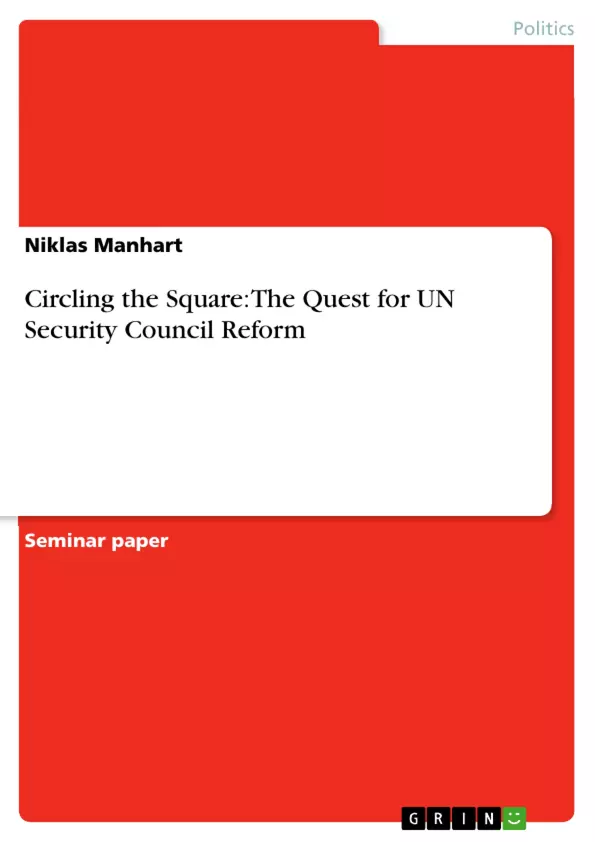In the realm of international politics, few debates have become as tedious as the quest for United Nations (UN) Security Council reform. After an overview of the SC's role and functions, this essay discuesses previous attempts of reform and the reform models at stake. Weighing the balance between efficiency and legitimacy, this essay argues that the addition of new permanent members and a change of veto regulations are red lines which cannot be crossed, and that, instead, the addition of six non-permanent members might be the least common denominator.
Inhaltsverzeichnis (Table of Contents)
- Introduction: The Show must go on
- The Security Council of the UN
- Structure and Role
- Decision History
- Reform of the Security Council
- Criticism
- Reform history
- Reform proposals
- A More Secure World
- The G-4 Model
- Uniting for Consensus
- African Union Proposal
- Single European Seat
- Merger with G-8
- Deliberation Rights without Membership
Zielsetzung und Themenschwerpunkte (Objectives and Key Themes)
This essay explores the challenges and opportunities of reforming the United Nations Security Council. The central objective is to analyze the arguments surrounding potential reform models, highlighting the complexities of balancing legitimacy and efficiency in international decision-making. Key themes examined include:- The role and effectiveness of the Security Council in maintaining international peace and security
- Criticisms of the current structure and decision-making processes of the Security Council
- Historical attempts at reform and the enduring challenges faced in achieving consensus
- Analysis of various reform proposals and their potential impact on the Council's legitimacy and effectiveness
- The role of permanent and non-permanent members in shaping the Council's decisions
Zusammenfassung der Kapitel (Chapter Summaries)
- Introduction: The Show must go on: The introduction sets the stage for the essay, highlighting the enduring debate surrounding UN Security Council reform. It underscores the need for a more representative and effective body while acknowledging the inherent challenges in achieving consensus. The essay aims to analyze the interplay between legitimacy and efficiency in the context of reform proposals.
- The Security Council of the UN: This chapter provides a comprehensive overview of the Security Council's structure, role, and historical decision-making processes. It discusses the Council's primary responsibility for maintaining international peace and security, including its authority to impose sanctions, deploy peacekeeping forces, and take military action against aggressors. The chapter also examines the role of the permanent and non-permanent members, highlighting the unique power of the P-5 and the significance of Council approval in legitimizing international actions.
- Reform of the Security Council: This chapter delves into the criticisms directed at the Security Council, exploring issues such as its membership imbalance and the perceived shortcomings of its decision-making procedures. It examines historical reform attempts and analyzes various contemporary proposals, including the G-4 model, the African Union proposal, and the single European seat initiative. The chapter also discusses the potential implications of these proposals for the Council's effectiveness and legitimacy.
Schlüsselwörter (Keywords)
This preview focuses on the key topics and themes surrounding UN Security Council reform, exploring concepts such as international peace and security, legitimacy, efficiency, decision-making processes, membership structure, veto power, and reform proposals. It examines the historical evolution of the Council, including its decision history, the Cold War period, and the post-Soviet era. The analysis incorporates diverse perspectives on the challenges and opportunities of reform, acknowledging the complexity of balancing the interests of various states and regions.
Excerpt out of 13 pages
- scroll top
- Quote paper
- Niklas Manhart (Author), 2009, Circling the Square: The Quest for UN Security Council Reform, Munich, GRIN Verlag, https://www.grin.com/document/189002
Look inside the ebook



